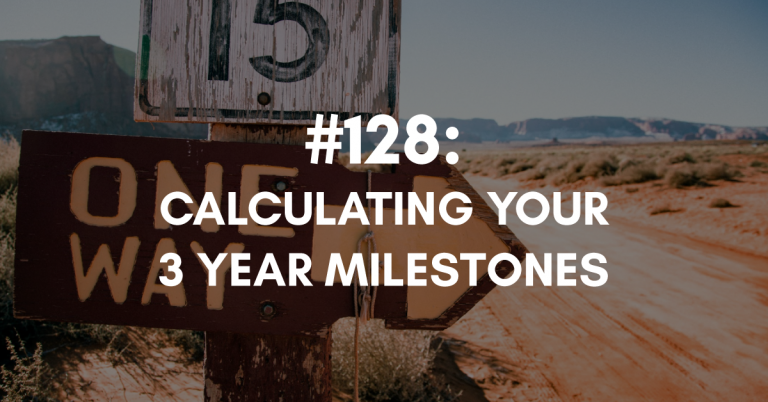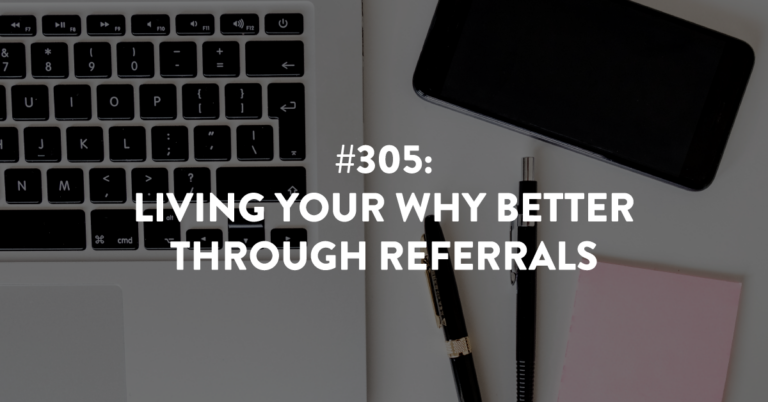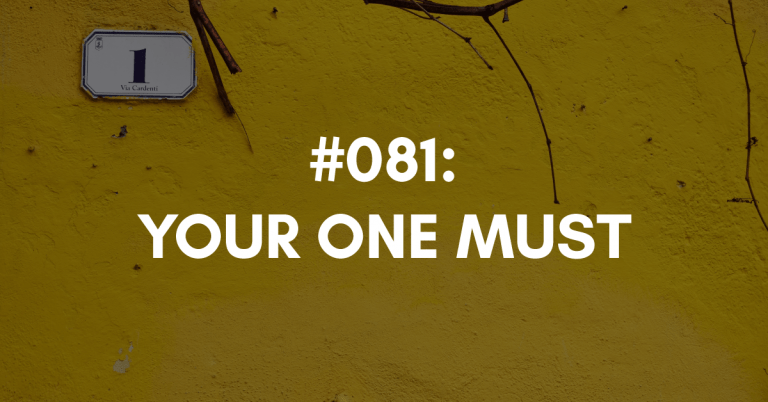Ep #287: Reverse Goal Setting
Reflecting on the past and planning for the future. Goal setting is not just about what you want your business to achieve; it’s about envisioning the life you want to live.
As we approach the end of the year, it’s crucial to reflect on how 2023 unfolded for you. But here’s the game-changer: instead of setting goals for the upcoming year in isolation, we’re going to reverse-engineer them.
By basing your 2024 goals on a five-year vision, three-year milestones, and a one-year plan, you’ll set yourself up for incredible success. Trust me, this method works wonders!
Reverse goal setting is the key to achieving your business goals! Join me as I walk you through this powerful process.
Links Mentioned During the Episode:
Episode #234: Reversing Your Way Forward, Part 1
Episode #235: Reversing Your Way Forward, Part 2
The 10-Year Goal Guide: Create a Future You Love Using the Power of 10-Year Goals by Kathy Brown
Want to join the Building a Referable Business™ coaching program or check it out to see if you’re a good fit? Your first step is to apply.
Next Episode:
Next episode is #288, which is another episode created with you and your needs in mind.
Download The Full Episode Transcript
Read the Transcript Below:
Stacey Brown Randall: Long-time listeners of the podcast, you know what time it is. It’s reverse goal setting time.
Hey there, and welcome to episode 287 of the Roadmap to Referrals podcast, a show about helping you build a referable business. I’m your host, Stacey Brown Randall. My journey from a business failure to a successful business now 10 years in, I know generating referrals naturally and consistently has made all the difference. Working with clients around the world, we leverage the science of referrals, protect relationships above all else, and help you build a referable business.
Towards the end of the year, you really should be thinking about reflecting back on how the year went, how did it unfold for you, and making plans for next year. But the plans you set for next year should be goals that are actually based on something further out so that you can reverse your way into making them happen.
In the past, and my longtime listeners know this, I would dedicate a number of episodes in December to my proprietary process called reverse goal setting. But this year, I’m doing it a little bit different and I’m gonna give you one episode as an overview because I really can’t let an entire year go by and I really can’t let December go by without talking about the importance of reverse goal setting.
I mean, just goal setting in general, but I like it the way I teach it because it helps people actually see things and puts things in perspective, which is really important when you’re trying to actually make goals happen and you lose your motivation by, oh, I don’t know, February 1st, right?
All right, but I am just doing one episode this go-round. Now, if you want to dive in deeper to this process, I invite you to just go and check out last year’s episodes. Those are episodes 234 and 235. Or you can go back another whole year to the December episodes, and you can catch those episodes as well.
In the past, I mean, I’ve been doing this podcast now for five years. So in the past, there’s been some Decembers where every episode was dedicated to reverse goal setting. I’ve noticed every year I’m shrinking it down.
Last year, only two episodes in December were dedicated to the reverse goal setting process. And this year, only one. And that’s probably where we’ll stay and hang out. The reason for this is that I teach referrals. All day, every day. I eat, sleep, and breathe this stuff.
You know, if you’re a longtime listener of this podcast, that’s what I talk about more than 80% of the time. Sometimes I do go off topic, and we talk about other things you need to know regarding being a business owner, running your business, and business growth strategies.
So we don’t just only, only talk about referrals. But the majority of the time, we do. But this is a process that is near and dear to my heart. And I’ll be doing a part of it with the folks who attend my retreat, who are members of my coaching program, BRB.
They actually spend, if they want, it’s a bonus, it’s free, it’s optional, they don’t have to, but they come to Charlotte, they spend two days with me, and we spend actually day one on reverse goal setting and reflecting and paying attention to where we’re going. And then we spend day two diving into all things referrals.
So this will always be a part of my world. I will always do the reverse goal setting process for myself every year, as I have done for over a decade now. And I think it’s really important.
So, yes, this is not referrals. If that means, hey, this is not for you, this episode, you have my permission to skip it. We’ll catch you next week.
But I want to dive into this and just kind of give you a high-level overview of the things you need to know. So here’s what you need to know about reverse goal setting.
The first step is that you’ve got to do some reflecting. You’ve got to figure out how the year went. I actually have some metrics in my business that I will track every year.
Like, I’ll track revenue. I’ll track profit. I’ll track percentage of my operating expense. I will absolutely track how much I paid myself. And then I’ll track other things, right?
And I’m not getting into the nitty gritty, like how many referrals did I receive? This is still pretty high level for me when I’m reflecting overall on the business.
I really wish you guys could see me talking with my hands right now because they are all over the place as I’m talking about these different parts. But okay, I digress, sorry. So you have a visual now.
But I think when you have metrics, but I like to track these metrics year to year. So what was my revenue last year as compared to the year before? What was my profit last year as compared to the year before? How am I doing with my operating expenses? What percentage am I falling in within how much I’m spending on expenses? That’s what operating expense is.
Of course, how much am I paying myself? But then I’ll also check how many new clients did I bring on board or how many repeat clients did I have as well?
So you just need to look at the metrics that make sense for you. I don’t track more than like five or six in any given time in terms of comparing this year to last year to the year before. But reflecting is a big part of it.
Also, as part of my reflecting, I’m going to ask some questions like, what was I most proud of that I accomplished in 2023? I’ll also ask questions like, what did I get excited about or energized about?
One of my favorite questions to ask is, what felt heavy this year? So I am actually doing things different in my business this year, because at the end of last year, at the end of 2022, I was like, wow, that felt really heavy. I don’t want to do that again. So guess what? I’m the owner. I’m in charge. I just said, I’m not doing that again. So then I didn’t. And it was great. And I really appreciate it.
I mean, you have to make conscious decisions and trade-offs, right? You decide not to do something, right? There’s always going to be a trade-off in that case. But for me, it’s not just the metrics. It’s also reflecting back on the year.
And sometimes I actually have to look into my calendar and be like, what did I do in January again? Just kind of remind myself and pay attention. When did we do different promotional pushes for my online program? Or when did we do promotional pushes for my coaching program, Building a Referable Business? When did we do this? And when did we do that?
And my goal, just so you guys know, is always to do less. Not like the least amount of effort. That’s not what I mean.
I just mean like, I just think that we get caught in this do more, do more, do more. Say yes, say yes, say yes. And I’m all about how many times can I say no, but still take care of my clients and still keep my business running the way that I want it to. Because we all have a life to live outside of our business four walls, right?
And so as I’m doing reflecting, there’s questions that I’m answering. I’m talking about, hey, what goals did I have for this year? What did I accomplish? What are my biggest opportunities for 2024? These are all the kind of questions that I would ask in a reflecting stage.
And then you move into step number two. And step number two is what I call the five-year vision. The reason why the reverse goal setting has that name, it’s because I want you to reverse into what your goals are for next year. And how you do that is by going further out.
Now, I have a really, really good friend, Kathy Brown. who actually teaches a 10-year goal process. So I’m gonna link to her in the show notes because I just think her stuff is fabulous.
And so she’s actually got some resources that you can go and check out about like, okay, wow, a 10-year goal, what is that? What does that mean? That’s so far away. It feels far away until you get older. And then you’re like, that’s not actually so far away. So I’ll link to her 10-year goal.
I have done the 10-year goal process with her. I think it’s really, really cool. But I have always traditionally taught a five-year vision.
Where do you want to be in five years? What do you want your business to look like? What do you want to have accomplished? What life experiences did you want to have?
And we look at this holistically because you’re a whole human. So it’s not just what you want your business to do, but it’s also like, what do you want your life to look like that you’re living?
So whether you do that for a 10 years, right, or five years, this process for me, we go out five years, I think it’s super valuable to go out even further. And these things can like, meld in together perfectly.
So definitely go to the show notes page for this episode if you want to check out my friend Kathy Brown’s 10-year goal information that she has. And again, the show notes page for this episode is StaceyBrownRandall.com/287. That’s for episode 287.
But the five-year vision is really like, where do you want to be? Like, in my instance, a five-year goal for me, like many, many years ago was I want to have a published book. Well, now I do. Right? Like, it’s like, where do I want to be in five years?
Maybe you’re making $250,000, and you really, in five years, you’re like, I should be making $750,000. Right? Maybe you’re like, wow, I just started my business, and in five years, it would be amazing to make $250,000. I mean, we’re all in different places.
I have some people who will do this, and they’ll be like, you know what? We have three locations, and I want to grow to seven. Great. Seven locations it is in five years. Right? It’s wherever you are in your business and in your life as to what do you want.
I do want to say this, and I’m just going to go ahead and say this at this point, and I’ll probably mention it again if I remember before this episode is over, and that is, this is your life, and you’re the only one who gets to live it, and you’re the only one who truly actually gets to experience it from within your own skin.
So please do not pick things because you think it’s going to impress someone, or you think it’s what someone else would want for you. It is okay to want more. It is also okay to want less.
Let me say that again. It is okay to want more. It is also okay to want less.
So whatever that means to you, however you hear that today, however you receive that and where you are, let that be your guide for your five-year vision.
Now, one of the favorite things I always do, okay, favorite was not actually the word I intended to use there because there’s nothing fun about this, but it’s super important and you have to do it. When you sit down to do your five-year vision, you actually need to write down how old you’re going to be in five years. Yeah, December 31st, five years from now, how old will you be?
That could be painful for some of us. Some of us are like, woo-hoo, I love my birthday. Celebrate getting older. That’s not who I am. That’s not where I go. I’m like, oh my gosh, I can’t believe I’m going to be that old. That’s typically my response.
But the minute you have to say how old you’re going to be, it really puts things in perspective of what you want to accomplish with your life. You map out your personal five-year vision.
Hey there, pardon the interruption. Isn’t it time you take referrals really seriously in your business? Well, if that time is now for you, please don’t go alone. I would love to work with you side by side and help you, give you the roadmap that you need to make referrals a reality in your business in 2024. I’d love to show you exactly how to do it. If you want to double, triple or quadruple your referrals and do it without asking for them or compensating for them, It’s possible. It’s all waiting for you inside my coaching program, Building a Referable Business. Find all the details of the program and, of course, the link to complete your application at StaceyBrownRandall.com/referable. Now back to the episode.
Okay, our next step, which is step three, is our three-year milestones, which basically means when you’ve set your five-year vision, you come off of that to the three-year mark and you ask yourself, okay, if I said in five years I wanted to be at $500,000 or in five years I wanted to actually have a smaller business and get rid of a part of my business.
Like whatever it is, wherever you say you want to be in five years, where do you need to be in three years to be on pace for your five-year vision to become a reality?
Now, for some folks who go through this, you find that actually you undershot your five-year vision. Because you’ll get to your five-year vision, and you’ll be writing down your three-year milestone, and you’re like, wait, I can get to my five-year vision in three years.
The three-year milestone will be a carbon copy of what the five-year vision is. That just means you undershot, and you may want to change your five-year vision, right? So then you set a three-year milestone.
For every bullet point is how I kind of talk about these things, but for everything you write down, for every bullet point you write down of what is a part of your five-year vision, you have to have a corresponding three-year milestone to it.
So if I said, in five years, I want to have five books published, that sounds terrible, actually, as somebody who’s published a book and trying to get her second one out the door. But let’s just say I wanted to have five books published in five years, and I’ve only published one. At the three-year milestone, if I haven’t published book probably three, maybe getting close to publishing book four, probably not going to hit the five-year milestone of having five books published in the next five years.
That’s just how it works out from a math perspective. Right? So for every five-year bullet point, every vision point you wrote down for that five years, you’ve got to map it to a three-year milestone so that you know you’re on pace to accomplish it.
And then you move into our last step, step four, and that’s our one-year plan. This is like a repeat of the three-year milestones, but it’s the same thing at the end of one year. So at the end of 2024, where do you need to be to be on pace for that three-year milestone to be a reality, to be on pace for that five-year vision to be a reality?
Do you see how we started big and then we reversed into actually our one-year plan? So we go five-year vision, three-year milestones, one-year plan.
And that one-year plan effectively becomes your goals for 2024. But really, they’re just the first step in the plan to you meeting and arriving at your five-year vision because you’ve determined that that’s important to you.
This also helps when it’s like March. or July, or September, and you’re tired in the year. And you’re looking at this one-year plan, right, you’re looking at your goals for the year. And you’re like, I’m really tired, I don’t know if I want to do this, or I’ve lost motivation, or I’ve lost focus, or I kind of forgot that I even had goals that I set at the beginning of the year.
It calls your attention back to your why. Because what you’re doing for 2024 is actually mapping to what’s going to be happening in your business or in your personal life by the end of 2027 and then the end of 2029.
I’m going to be really honest with you guys. I just did that math in my head. I didn’t actually write that down, so I hope I have that mapping correct.
So the end of 2024 is your one-year plan, and it maps into what’s going to happen three years from now. That would be your three-year milestones. That maps into your five-year vision.
It helps establish motivation because it calls into purpose your why. So in July or in March, when you’re really tired and you’ve forgotten about your goals, you can ask yourself, well, if I don’t do these things this year, it throws off the whole three year and five year plan. So I got to decide what am I going to do?
Am I going to refocus or am I just going to let that plan, that goal, die on the vine. It’s a decision. We all got to make it. We’re grownups. That’s what happens. That’s what it looks like.
So again, for a recap, reflect on how this year went. Compare it to previous years. But don’t stop there. That’s just focusing maybe on your gap or your gain. I don’t know. But set goals. But let’s set goals for next year based on them being a part of a five-year vision with three-year milestones and a one-year plan that effectively becomes your 2024 goals.
And then hit me up. Direct message me on LinkedIn or on Instagram or shoot me an email and let me know what you’re planning for 2024. I would love to hear from you.
So the resources I mentioned in this episode, like Kathy Brown’s information and links to the episodes from last year, where I went into this and deeper with episode 234 and 235, those will be found on the show notes page for this episode, which is StaceyBrownRandall.com/287.
Okay, we’re back with another great episode next week, created with you and your needs in mind. Until then, you know what to do, my friend. Take control of your referrals and build a referable business. Bye for now.







